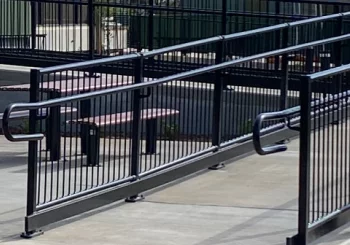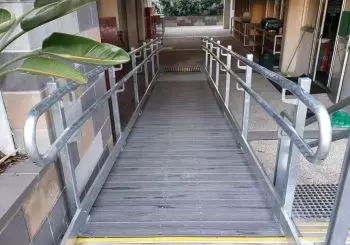It is incredibly essential to ensure the safety of a wheelchair ramp.
The material and construction techniques are essential aspects when it comes to safety. Here are a few of the different materials used for ramps and the slip-resistant features that would work best for them:

This is one of the most popular materials used in the construction of wheelchair ramps. Besides being a permanent feature, it requires specialised installation and is relatively slip-resistant. These features can easily last you anywhere between 15 to 20 years if you opt for high-quality hardwood and ensure it’s well maintained.
Although wood ramps require high maintenance, they will definitely benefit from a slip-resistant surface. Installing rubber strips or applying slip-resistant paint on these surfaces is a great option. However, there are several different products available in the market that offer excellent traction.
A few other options to create a slip-resistant surface include rubber tiles and rubber matting. You can also install mini-mesh grating to increase the traction.
2. Metal
Metal ramps, on the other hand, are durable and are easy to maintain. They, however, require anti-rust treatments from time to time. Although wooden ramps have a few metal sheets installed on them, these features are comprised entirely of metal. See to it that there aren’t any gaps in the surface of the sheets during installation. This can result in canes or crutches getting stuck in them. To prevent slippage, these features require rubber strips.
3. Aluminium
Aluminium ramps are highly durable, semi-permanent features that, unlike other metals, don’t rust. These ramps are relatively easy to dismantle and easy to install in new locations as they’re made up of several sections. Although these ramps offer considerable traction, it might be a good idea to add rubber strips for increased safety.
4. Cement
Cement is another popular material used for ramp installations. However, these require a solid base and are permanent features. The installations can last for many years if they are well maintained. The drawback is that the surface tends to lose traction during the rains.
Neglecting maintenance can result in surface cracks over time. A great way to prevent it from happening is by installing rubber paving on the ramp, or even rubber strips along the length of the feature.
The Slip-Resistance Factor
Since ramps have slopes, it’s crucial that the surfaces be made using anti-slip materials. If you do not take the proper precautions, the risk of slippage while moving on the slope increases significantly. It is challenging to use ramps if they are slippery. But you can easily prevent accidents from taking place by installing a slip-resistant surface on them, making the structures much safer to use.
Durable and Resilient Wheelchair Ramps From Adapta
We at Adapta are the wheelchair ramp experts and offer our services to residential as well as commercial clients. We have a seasoned team will provide you with all the relevant information on the different types of ramps, their layouts, and other specifications.
Our high-grade, weather-resistant modular ramps come in a wide range of designs and styles and are suitable for different types of settings. We will help you make a well-informed decision on the types of slopes that works best for your property. Based on your settings, specific requirements, preferences, and budget, you can select the wheelchair ramp’s style, layout, etc.
We offer a wide variety of ramp layouts and options. You can call 1800 232 782 or contact Adapta through this form, and one of our experts will contact you shortly. They will have detailed discussions with you to understand your needs before recommending the right solutions for your property.



